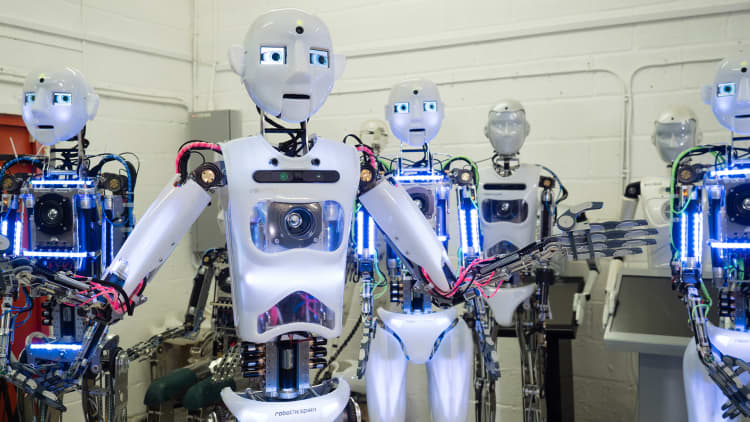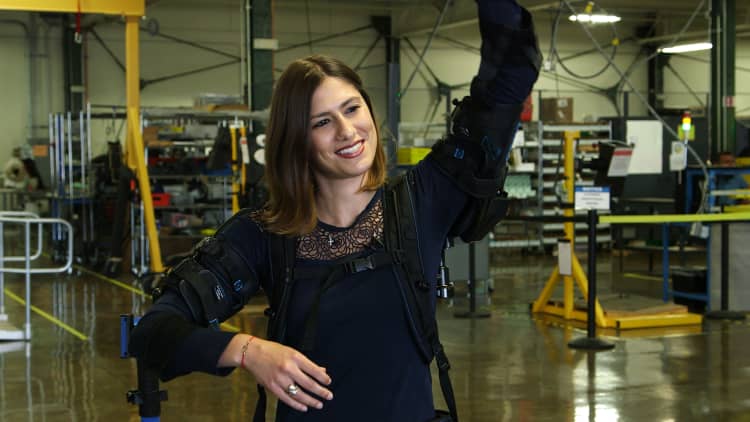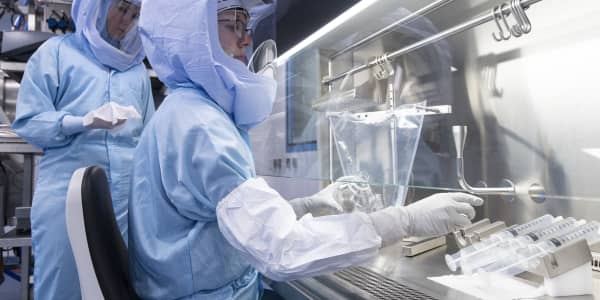At a recent technology show in Tokyo, a large robot arm reached into a full-sized mockup of a shipping container and began unloading boxes from it. Set on a platform that moved back and forth, the robot was doing a job usually carried out by warehouse workers and forklift operators. The goal of the company that's developing it, Mujin, is total automation.
The system, still a prototype, doesn't work perfectly — it accidentally damaged a box during the demo — but it's going to be trialed in warehouses in Japan this year.
"Lifting heavy boxes is probably the most backbreaking task in warehouse logistics," said Mujin's American co-founder and CTO, Rosen Diankov. "A lot of companies are looking for truck unloading systems, and I believe we're the closest to commercialization."
More from At Work:
This start-up created the first US farm run by robots
How AI is changing the way you apply for jobs
The Tokyo-based start-up is aiming to be a leader in automating logistics processes. To do that, it's building robot controllers and camera systems and integrating them with existing industrial robot arms. The key product here is the controllers — each about the size of a briefcase, one for motion planning and one for vision — that act as an operating system that can control the hardware from any robot manufacturer. If a goal such as grasping an object is input, the controllers automatically can generate motions for robots, eliminating the traditional need to "teach" robots manually. The result, according to the company, is higher productivity for users.
Simply put, the technology — based on motion planning and computer vision — makes industrial robots capable of autonomous and intelligent action.
Mujin turned heads when it showed off its transformation of a warehouse operated by Chinese e-commerce giant JD.com. The 40,000-sq-m facility in Shanghai began full operations in June. It was equipped with 20 industrial robots that pick, transfer and pack packages using crates on conveyor belts, as well as camera systems and Mujin robot controllers. Other robots carted merchandise around to loading docks and trucks.

Amazon also has invested heavily in automating its fulfillment centers, buying Mass.-based robot company Kiva Systems for $775 million in 2012, but JD.com called its facility the world's first fully automated e-commerce warehouse. Instead of the usual 400 to 500 workers needed to run a warehouse that size, it needs only five. And their job is only to service the machines, not run operations.
Standardizing total automation
"My goal is to automate warehouses in America and make a lot of success stories there," said Diankov. "But will people value that, and are there enough people with expertise to do it? That's why we started in Japan."
Mujin's plan is to move away from customization for every client and standardize a complete automation package.
"Unfortunately, just having a robot system work perfectly is not enough, and we need to have the equipment and system around the robot to finally allow it to contribute to the operations of the business," said Diankov. "Once there are enough solid standardized components for warehouse automation, we can focus our energies to quickly deploy and perfect them."
Born in Bulgaria, Diankov moved to the United States at age 10 and studied robot engineering at Carnegie Mellon University, where he earned a Ph.D. After stints at seminal California robotics start-up Willow Garage and the University of Tokyo's JSK Robotics Lab, he founded Mujin in 2011 with CEO Issei Takino.
Staffed by about 70 people, including many non-Japanese, the start-up is headquartered in a working class district on the eastern side of Tokyo. While preaching the value of automation at trade shows, the company reminds people that the number of workers in Japan is dropping by 2,125 per day, due to the country's low birthrate and aging population.
"In the U.S., robot technology is often undervalued and directly compared to the value of human workers," said Diankov. "If you're going to be competing with that from day one, maybe you have no room to grow quickly. In Japan they have a mindset that values robotics much more, even if it sometimes doesn't make economic sense. They're willing to jump into investments into robotics."
Diankov believes fears of robots taking jobs from people don't reflect the reality of the workplace.
"Introducing robots creates more jobs, and history has shown that's been the case," he said. "Companies that have embraced automation, like Toyota — it's the biggest car company in the world now."
No fuzzy logic
Mujin is building smart machines based on model-based approaches to robotics. Unlike applications in the current fad for deep learning, Mujin's controllers are not learning to accomplish a task through trial and error. There's no guesswork involved. They're programmed to do a specific task very well, and every position of every joint of a Mujin robot is tracked, down to the millisecond. While that lowers the possibility for error, it also imposes a massive computational burden on the controllers, so they're equipped with fast microchips that can evaluate tens of thousands of possible moves, choosing the best one in less than a second.

"The approach is like that of a train, plane or rocket — you don't want it to be self-learning, just predictable when it goes from A to B," said Diankov. "That's how you create innovation, with perfectly predictable systems. That's what we're trying to do with robotics. I like to call this machine intelligence, not artificial intelligence."
Rosen said Mujin is probably the only robotics start-up doing this advanced robotics stuff that's not working at a loss. The company has raised $7 million in VC funding from Tokyo venture capital firms JAFCO and the University of Tokyo Edge Capital. It's also earning revenue from projects for Japanese firms, such as Askul, which specializes in e-commerce for office supplies, and Paltac, a logistics firm, as well as JD.com in China.
In the U.S., robot technology is often undervalued and directly compared to the value of human workers.Rosen Diankovco-founder and CTO, Mujin
Mujin also has managed to penetrate Japan's conservative $1.4 billion robot manufacturing industry, dominated by global players like Fanuc and Yaskawa Electric. It's persuaded robot makers to loosen their tight grip on their confidential software so that Mujin controllers can directly run robot servomotors. Now the start-up wants to scale as quickly as possible and expand into the United States.
"End customers are choosing Mujin first before they choose the robots," said Takino, who met Diankov when he was a salesman with Iscar, an Israeli machine tool company owned by Berkshire Hathaway. "We are robot controller makers, which is like Windows for industrial robots. Windows was popular for the killer application it introduced — browsing the internet. We want to make killer apps like bin picking as easy as possible."
"We're at the cusp where all these different automation technologies — including robot hardware, sensing hardware, AI algorithms, conveyor systems and sorting systems — coming together," said Diankov. "Five years ago it was not possible, because there were too many unknowns. But today there's a solution for each of these different components in the warehouse. And now it's a race to see which company puts all the components together the fastest and has the end result. There are several choices for each component, and the jury's still out on what a completely automated warehouse will look like."
WATCH: Ford is using bionic suits to help employees work safer







